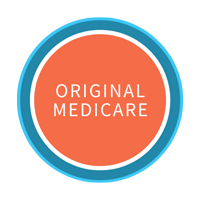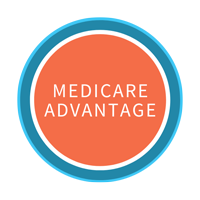If you’ve delayed looking into Medicare because you’re feeling overwhelmed, know that many other North Carolinians are feeling the same way. Once you learn about the program and its terms, Medicare won’t be as complex, and you can take it step by step.
In this resource guide, you’ll learn about the difference between Medicare and Medicaid, Medicare coverage options, services, procedure cost estimates, and the application process.
What is Medicare?
Medicare is a federal health insurance program for people 65 and older. You may qualify earlier if you have a disability, End-Stage Renal Disease (ESRD), or Amyotrophic Lateral Sclerosis (ALS).
You can select either Original Medicare or Medicare Advantage (also known as Part C or MA Plans) as your Medicare coverage.
Original Medicare option: You can opt-in or opt-out of different benefits (called “Parts”). If you opt-out, you may receive a monetary penalty to register for a “Part” during another enrollment period.
Medicare Advantage option: You can choose a plan to fit your medical needs when you sign up. If you select one and later want to change it, you can pick another plan during a separate enrollment period.
Why is Medicare often confused with Medicaid?
Medicare and Medicaid overlap eligible populations, which means you may qualify for both federal Medicare health insurance and state Medicaid healthcare assistance. If you’re approved for both, you can use each to cover your medical expenses. Medicaid may pay the remaining out-of-pocket costs for qualified services that Medicare doesn’t fully cover.
The federal government is in charge of Original Medicare coverage. You can either opt-in or opt-out of Part A and Part B, but you have to sign up separately for Part D. The list below explains what each “Part” covers:
- Part A may cover hospital inpatient care, nursing facility care, nursing home care, hospice care, and home health care.
- Part B may cover services that are either medically required or preventative.
- Part D may cover certain prescription drugs depending on the drug’s tier and cost. During enrollment, you must sign up for Part D drug coverage at the same time as Original Medicare. If you have other types of health insurance, signing up for Part D coverage may work differently.
Since services are subject to change, we say “may cover” to notify you to check with your Medicare “Part” coverage.
Original Medicare lets you go to any U.S. doctor or hospital that accepts it. Due to the ability to go to any Medicare provider, you may need Medigap (supplementary insurance) to help cover out-of-pocket expenses.
Private companies approved by the federal government provide Medicare Advantage coverage (also known as Part C or MA Plans). The list below explains what each plan type covers:
Health Maintenance Organization (HMO) plans
- have in-network providers. If you go to an out-of-network provider, you may have to pay the full cost of services.
- don’t offer drug coverage unless you select an HMO plan that includes Part D during enrollment.
- may require you to select a primary care doctor.
- may require you to have a primary care doctor’s referral to see a specialist.
- don’t cover emergency care, out-of-area urgent care, and out-of-area dialysis.
- may require you to get prior approval for medical services.
Preferred Provider Organization (PPO) plans
- have in-network providers. You do have the option to go to an out-of-network provider, and services will cost more.
- don’t offer drug coverage unless you select a PPO plan that includes Part D during enrollment.
- don’t require you to select a primary care doctor.
- may not require a primary care doctor’s referral to see a specialist.
- cover the costs for emergency and urgent care.
Private Fee-for-Service (PFFS) plans
- share the cost of medical services with you by covering a predetermined amount so that you can pay the remaining balance for the medical service.
- allow you to join Part D if it isn’t included in your chosen PFFS plan.
- don’t require you to select a primary care doctor.
- don’t require a primary care doctor’s referral to see a specialist.
- may not cover out-of-network care and emergencies.
- are unable to be combined with Original Medicare.
Special Needs Plans (SNPs)
- provide coverage for people with specific diseases.
- include Medicare Part D drug coverage.
- may require you to select a primary care doctor.
- may require a primary care doctor’s referral to see a specialist.
- provide coverage to those who need nursing care at home, have chronic/disabling illnesses, or receive Medicare and Medicaid.
Medicare Medical Savings Account (MSA) Plans
- may cover medical service costs once you meet your selected plan’s high deductible.
- provide a choice of providers and services.
- act as savings accounts for healthcare expenses.
Watch the video below to learn more about various plan options.
There are two search tools available to view Medicare services and coverage.
Check out this video to learn how to use the services search tool.
Check out this video to learn how to look up procedure cost estimates.
To sign up for Original Medicare, you need to apply through the Social Security Administration (SSA). You can enroll for Part A and Part B using the SSA online application during an enrollment period that applies to you. The list below explains when enrollment periods occur:
- The Initial Enrollment Period is three months before the month you turn 65 and lasts for seven months.
- The General Enrollment Period is from January 1st to March 31st, but keep in mind that your premium may increase if you choose to forego the Initial Enrollment Period.
- The Special Enrollment Period is for those who meet specific criteria and lasts for eight months, including the month when your current health plan or employment ends.
- The Open Enrollment Period is from October 15th to December 7th for those who already have Medicare and want to join a plan, switch to another one, or drop one (which may result in a penalty).
- The Medicare Advantage Open Enrollment Period is from January 1st to March 31st for those who already have a Medicare Advantage plan and want to switch their plan.
Check out the video below to learn how to apply for Medicare Part A & Part B through the Social Security Administration (SSA). The video is not from a government source (none are available at this time), but it provides a helpful step-by-step guide:
If you miss your Initial Enrollment Period or drop coverage, there may be monetary penalties. The list below explains how penalties work:
Part A Late Enrollment Penalty
- If you have to buy Part A with a premium and don’t sign up for it during initial enrollment, you’ll be penalized with a higher premium for a certain amount of time, depending on how long you wait to sign up.
- If you qualify for special enrollment, you may not have to pay the late enrollment penalty.
Part B Late Enrollment Penalty
- If you don’t sign up for Part B during initial enrollment, you’ll be penalized with a higher premium for a certain amount of time, depending on how long you wait to sign up.
- If you qualify for special enrollment, you may not have to pay the Part B late enrollment penalty.
Part D Late Enrollment Penalty
- If you don’t sign up for Part D during initial enrollment, the penalty is a permanently higher premium.
- If you drop Part D coverage or instead choose your employer’s drug coverage, you’ll be penalized with a permanently higher premium if 63 days have passed without coverage.
Once you enroll in Original Medicare (Part A & Part B), the Centers for Medicare & Medicaid Services (CMS) will send you a packet, handbook, and your Medicare card in the mail.
The SSA requires a personal my Social Security account to replace your Medicare card.
Check out the video below to learn more about the my Social Security account.
To report Medicare fraud/abuse, call the phone number for your Medicare plan.
Disclaimer: Medicare coverage, plans, and prices are subject to change.

